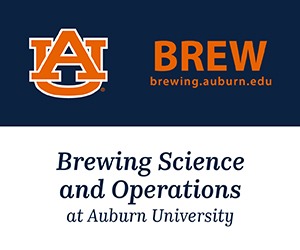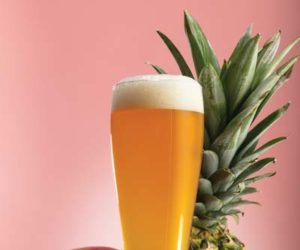Tropical Thirst
Biotransformation in the brewery
Hops have traditionally been an essential ingredient in brewing and their increased usage reflects the changing tastes of beer drinkers. To meet their desire and to create new and interesting beer styles that stand out in an increasingly crowded market, brewers have been implementing techniques, such as dry hopping during fermentation, to enhance the hops and yeast impact on beer aroma. Indeed, while fermenting, yeast cells can metabolize and transform compounds other than sugar in the wort, converting anonymous compounds into something new.
“Biotransformation” is the umbrella term used to encompass these flavor-changing reactions during active fermentations. Thiols, terpenes, and esters are all affected differently by yeast metabolic reactions, such as esterification of hop compounds, hydrolysis of hop glycosides to release monoterpene alcohols, and the release of polyfunctional thiols from amino acid conjugates. These biochemical processes generally enhance the fruit and floral aromas in the beer. Certain yeast strains have been found to exhibit higher levels of enzymatic activity associated with biotransformation, in particular β-glucosidase and β-lyase enzymes. These enzymes are involved in the hydrolysis of hop glycosides to release monoterpene alcohols and the release of polyfunctional thiols from non-aromatic precursors, respectively.
While the overall impact of yeast β-glucosidases on increasing terpene alcohols remains unclear due to discordant observations, yeast β-lyase activity has a bigger and more clear impact due to particularly low flavor thresholds of thiol compounds. It has become evident how this enzyme plays a key role in releasing desirable aromatic flavors in beer, adding to the complexity and character of the final product.
Chasing the Thiols
Polyfunctional thiols are among the most intense aromatic compounds found in fermented beverages due to the sulfur functional groups, resulting in an extremely low aroma threshold concentration (∼2−200 ng/L). Among others, the predominant polyfunctional thiols that are commonly found in beer are 3-mercaptohexanol (3MH), 3-mercaptohexyl acetate (3MHA), and 4-mercapto-4-methylpentan-2-one (4MMP). 3MH, for example, is known for its grapefruit and citrusy aroma, while 3MHA is associated with a passion fruit or guava-like aroma. 4MMP, on the other hand, can give beer a distinctive aroma of blackcurrant or grapefruit. Thus, beers containing higher levels of these compounds are expected to be perceived higher in tropical aromas.
In the hops, thiols exist in both free and precursor forms depending on varietal, growing location, and harvest. Free thiols are compounds that are already volatile, therefore unlocked, and ready to create aromas. Thiol precursors instead are bound to non-aromatic amino acids, cysteine and glutathione, and therefore non-volatile.
“Biotransformation” is the umbrella term used to encompass these flavor-changing reactions during active fermentations.
These precursors can be found in hops at significantly higher concentrations than their free forms. Concentrations of 3MH precursors have been reported 1,000-fold higher than the concentrations of free 3MH in Cascade hops. To create aromas, these compounds need to be cleaved by yeast’s β-lyases during fermentation, which break the carbon-sulfur bond and release the volatile thiol compounds.
While the rise of many hops has been related to their ability to impart free thiols to beer (e.g., Citra®, Tomahawk®, Nelson Sauvin™), other cultivars with a large pool of odorless conjugated thiol precursors could be re-evaluated, independently from their amounts of free thiols (e.g., Cascade). Additionally, it has been reported that malt can also be a source of cys-3MH precursors, although to a lesser extent. Given the vast pool of odorless precursors that have been identified in malt and hops, it is now clear there is a potentially underutilized resource allowing production of beer with higher tropical aromas using hop varieties that are otherwise low in free thiols.
Fruits of Yeast Labor
In Saccharomyces cerevisiae and pastorianus, the IRC7 gene encodes for a cysteine S-conjugate β-lyase enzyme that can release polyfunctional thiols from cysteine, thereby promoting thiol aroma in beer. The release of volatile thiols from conjugated precursors during yeast fermentation has been directly linked to IRC7 expression, which is involved in sulfur metabolism and amino acid biosynthesis and linked to the nitrogen catabolite repression. This means that, in the presence of favorable nitrogen sources, such as ammonium, IRC7 is repressed.
Instead, during periods of nitrogen scarcity for yeast, β-lyase is expressed more, because the yeast is going after the amino acid bound to the non-volatile thiol. In addition to regulation, thiol release is also affected by the coding sequence of IRC7. Most existing beer yeast strains have a limited ability to release polyfunctional thiols due to a 38 bp deletion in the IRC7 gene, resulting in a suboptimal enzyme, ultimately able to only convert minimal amounts into flavor-active volatile thiols.
Regarding less conventional brewing yeast, considerable β-lyase activity has been observed in S. uvarum and Torulaspora delbrueckii, making them a very attractive alternative for their ability to produce beers with superior sensory quality.
In the Brewer’s Hand
Overall, the number of thiol precursors in wort can be carefully influenced by the brewer’s choice of hop and malt, making the yeast choice critical. The inability of brewing yeasts to catalyze efficient biotransformation results in most thiol precursors remaining in the flavor-inactive form, at the cost of a significant loss in the potential tropical fruit flavor in finished beer. Since the IRC7 enzyme is directly related to thiol release, technical information on β-lyase activity is essential to decide which strain would best fit your recipe. Other synergetic solutions available are the pure forms of the enzyme to boost the activity during fermentation, as well as additives, such as Phantasm (leftover Sauvignon Blanc grape skins), that are being tested to increase the precursors available.
The below you will find a recipe with a few yeast strains available to the homebrew crowd. Here are a few recommended β-lyase-active yeast strains. Talk to your favorite yeast provider to learn what they have available.
- Omega Yeast OYL-405 (Helio Gazer Ale)
- Omega Yeast OYL-402 (Cosmic Punch)
- LalBrew Verdant IPA
- Berkeley Yeast Vermont Tropics
- Escarpment Laboratories Thiol Libre
- AEB Levulia Torula (*non Saccharomyces; it needs to be paired with a brewing yeast)
Reference
- Chenot, Cécile, et al. “Malt and hop as sources of thiol S-conjugates: thiol-releasing property of lager yeast during fermentation.” Journal of Agricultural and Food Chemistry 70.10 (2022): 3272-3279.
- Michel, M., et al. “Screening of brewing yeast β-lyase activity and release of hop volatile thiols from precursors during fermentation.” BrewingScience 72 (2019): 179-186.
- Svedlund, Natalia, et al. “Fruits of their labour: biotransformation reactions of yeasts during brewery fermentation.” Applied Microbiology and Biotechnology 106.13-16 (2022): 4929-4944.
- Development of Thiols and Thiol Precursors in different Hop varieties During Hop Harvest and their impact on beer flavor (brewersassociation.org)
Tropical Punch IPA

(5 gallons/19 L, all-grain)
OG = 1.060 FG = 1.012
IBU = 10 SRM = 4 ABV = 6.2%
Ingredients
10 lbs. (4.5 kg) North American 2-row pale malt
1.5 lbs. (0.68 kg) flaked oats
1 lb. (0.45 kg) North American red wheat malt
1 oz. (28 g) Cascade hops (mash hop)
2 oz. (57 g) Cascade hops (hopstand)
1 oz. (28 g) Citra® hops (hopstand)
2 oz. (57 g) Cascade hops (1st dry hop)
2 oz. (57 g) Citra® hops (2nd dry hop)
1 oz. (28 g) Cascade hops (2nd dry hop)
50 mL Berkeley Yeast Thiol Boost or 2.5 oz. (70 g) Phantasm Thiol Powder (optional)
1 mL AEB ENDOZYM® Thiol (optional)
Omega Yeast OYL-405 (Helio Gazer Ale), Omega Yeast OYL-402 (Cosmic Punch), or LalBrew Verdant IPA yeast
2⁄3 cup corn sugar (if priming)
Step by Step
Mash in targeting a saccharification rest temperature of 155 °F (68 °C), stirring the mash hops in with the grains at the start of the mash. Lauter as normal, collecting about 7 gallons (26.5 L) of wort in the kettle. Bring wort to a boil. You may want to add a few hop pellets to help with foam control.
After a 60-minute boil, chill the wort down to 175 °F (80 °C) then add the hopstand hops. Begin to actively whirlpool wort for 15 minutes then allow to settle for another 15 minutes. Quickly chill to yeast-pitch temperature and pitch the yeast of your choice.
Ferment within the yeast manufacturer’s recommended range. After roughly 1⁄3 of the fermentation is complete add the first round of dry hops along with Thiol Boost or Phantasm Thiol Powder, if using. After fermentation is complete, consider dumping yeast and first round of dry hops or racking into a purged container like a corny keg. Add second round of dry hops and the ENDOZYM® Thiol, if using. Wait five days, then it’s ready for final packaging. Keg and force carbonate to 2.4 v/v (much preferred technique), or prime and bottle.
Partial mash option: Reduce the pale malt to 0.5 lb. (230 g) and add in 5.5 lbs. (2.5 kg) of extra light dried malt extract. Place crushed pale and wheat malts along with flaked oats and mash hops in a large muslin bag and submerge into 1.5 gallons (5.7 L) of water with the goal of stabilizing the mash temperature at 155 °F (68 °C). Maintain this temperature for 60 minutes. Place grains in a large colander and wash with 1.5 gallons (5.7 L). Top up to 5 gallons (19 L), stir in the extract off heat, then bring to a boil and boil for 60 minutes.
Tips For Success:
Some of the optional ingredients may be difficult to source on the homebrew level. Just note that they are optional and may not have a huge impact on the final beer’s profile, depending on several factors.
While this recipe says the IBU count will be 10, there will be bitterness derived from the hopstand and dry hops not accounted for as iso-alpha acids.



